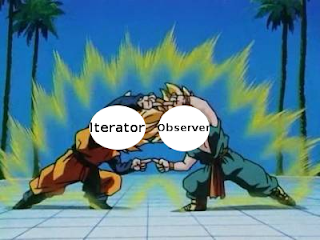I found a great video explanation of Reactive Programming in the flavour of Reactive Extensions Library done by Jafar Husain (Technical Lead at Netflix) . Here's a brief summary of the main concepts I extracted.
The term Reactive can be associated by analogy with someone throwing a lot of balls at you at the same time. You need to react quickly to try to catch them all. You don't have control over when you want the balls to be thrown at you, you just need to be prepared to catch them.
To start understanding Rx (Reactive Extensions), we need to have two basic design patterns in consideration: Iterator and Observer.
In Java we have an Iterable interface, which is an interface any type of collection can implement to allow consumers of a collection obtain items one at the time. That's how in Java we can use the foreach operator to traverse a collection. Because the interface provides a specific Iterator for the data type we are consuming in the collection. Three things can happen when using an iterator:
- Get the next item
- No more items to consume (end of the data stream)
- An error can happen (using exception throwing in languages like Java)
The Observer pattern is another well known design pattern where suscribers get suscribed to subjects in order to be notified when a change occurs in the subject. If we analize this pattern, we can find that it's very similar to the Iterator pattern in the sense that there is a producer and a consumer. Main difference is that in the Observer the producer is in control for when sending the data, while in the Iterator the consumer is in control. He decides when to pull the data from the producer.
- A way to indicate there is no more data
- A way to indicate an error ocurred
In the Observer you can only suscribe callback to receive data, but you cannot register callbacks for the event where is indicated no more data is going to be pushed (completion event), or to indicate an error happened. Reactive extensions is basically about unifying the observable pipe with the iterable pipe producing a new type called the Observable. It gives the same semantics of both the Iterable and the Observable.
There are a lot of interesting operations that can be done over iterables. Similar to SQL where there are a lot of operations that can be done over sets: filter, select, order, etc. What about if all the same things we can do over data sets residing in a table, could also be done over events (data arriving in). That is not a dream with Rx. It is possible to write SQL style queries over events. The difference is that the query is evaluated as data arrives. You can evaluate data in real time.
More and more code is becoming evented. We have a lot of asynchrouns calls both in client side (JS), and server side (Node.JS). That adds a lot of complexity in the application trying to handle all these
callbacks. The reactive extensions library provides this new Observable data type that establishes a powerful way to model events. By completing the missing semantics (end of data stream and error), you can now apply operations familiar in collections like map, filter, reduce, merge, zip, etc. All those things that could be done over data streams we can pull, now can be done over streams of data we can push.
Imagine the new Java 8 Stream API over data that is arriving dynamically over events pushed to you. Lot of things can improve in an application like serving faster data to consumers just to cite an example.
Still need more learning for this new paradimg, but at least I think this video covers fundamental concepts we need to have before getting our hands into the code.
Still need more learning for this new paradimg, but at least I think this video covers fundamental concepts we need to have before getting our hands into the code.
